The Ultimate Guide to Bird Baths for Pet Birds
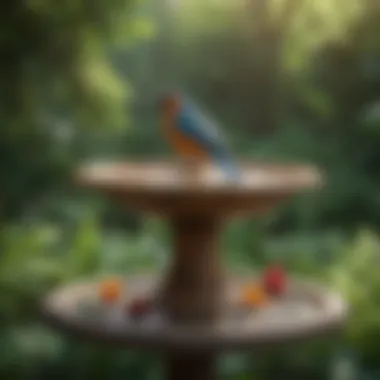
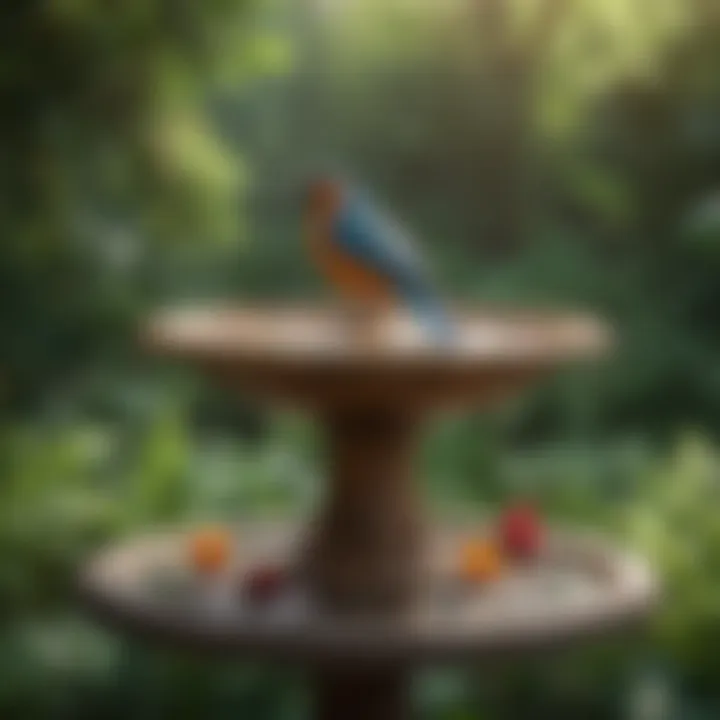
Intro
The well-being of pet birds is heavily influenced by their environment, and one essential feature in their habitat is the bird bath. Diving into the intricacies of bird baths reveals not just their importance but also methods in which bird owners can enrich their feathered friends' lives. This guide provides valuable insights, including types of bird baths, how they benefit avian companions, optimal maintenance, and safety measures to always keep in mind.
Bird baths serve multiple purposes. They aid in thermoregulation, help birds maintain proper feather condition, and are also a source of enrichment. Understanding the nuances surrounding these bathing areas can provide a healthier and happier life for our pet birds.
Care Tips
Caring for a bird bath goes beyond merely filling it with water. A structured approach should entail regular maintenance and an understanding of your bird's needs.
Daily Care Routines
Establish a system for daily routines. Filling the bird bath with clean water every day is crucial. Birds can be sensitive to contamination. Monitor their bathing habits to ensure they find comfort and safely use the bath. If you notice signs of reluctance or unease, observe their behavior closely.
Cage Setup and Maintenance
The setup of the bird's living space can influence their urge to bathe. Ensure that the bath is accessible yet separate to prevent it from disrupting essential areas like feeding stations. Reassess the cage layout periodically to maximize your pet's comfort and accessibility to its bath.
Hygiene and Cleaning Practices
By promoting hygiene, you help prevent diseases significantly. Clean the bird bath at least once a week using bird-safe disinfectants. Be mindful of intricate areas where residue might accrue. Also, rinse thoroughly to avoid any harmful chemical residues.
Seasonal Care Adjustments
Seasons can affect how often and in which manner birds use their baths. During warmer months, birds might want more frequent access to water to cool off. Ensure the bath is suitable for varying conditions. In colder weather, consider keeping water warmer or offering slight heating options.
Behavioral Insights
Understanding pet bird behavior can further enhance their bathing experience.
Understanding Bird Body Language
Deciphering body language is key to understanding comfort. Tail feathers, wing positions, and vocalizations serve as indicators of how your bird feels about the bath.
Common Behavioral Issues and Solutions
Pay tention to signs of anxiety or fear around the bath. If your bird seems resistant, consider introducing the bath slowly. Allowing birds to observe their fellow companions using the bath can encourage them.
Positive Reinforcement Techniques
Rewards can holistically change behaviors. Offer treats or compliments when birds display favorable bathing actions. Make the environment engaging yet secure.
Social Interaction Needs
Bonding through interaction is essential for mental wellness. Include bathing festivity for multiple birds to promote security and socialization.
Nutrition Guides
Bathe closely correlates with a bird's hydration and diet
Essential Diet Components
A balanced diet underscores health and behavior. Fresh fruits, vegetables, seeds, and grains must form the core. Each species may require distinctly formulized conditions.
Safe and Toxic Foods
This knowledge helps to avoid fatal errors. Birds should be spared from toxic additions like avocado, chocolate, or caffeine. Read up on lists of safe foods from reputable sites.
Supplements and Treats
Supplements may enhance nutrition. Choose ones catered for your bird's needs, like calcium or omega fatty acids. Treats should add variety but administered wisely to prevent obesity.
Feeding Strategies for Different Species
Feeding different species involves tailoring their diet. Budgerigars may thrive on seeds plan, while parrots benefit from broader food selections.
Wellness and Health
Health checks of birds should regularly occur. Watchful insight can identify problems early.
Routine Health Checkups
Schedule consultations with an avian vet to maintain health routines for prevention.
Identifying Symptoms of Illness
Observe for signs of illness, such as dull feathers, changes in eating habits, and vocal variations. Document shifts for veterinarian evaluations consequences.
Preventative Care and Vaccinations
Informs owners toward proactive needs ticking vaccination schedules follow recommendations by an avian veterinarian body.
Mental and Emotional Well-being
Offer support by engaging them through activities beyond necessities. Incorporate puzzle-solving and normal play to balance aspects.
Enriching Activities
Activities that promote physical and mental stimulation are paramount.
Toys and Playtime Ideas
Implement a variety of climbing, chewing, and foraging items into the cage to sustain engagement.
Training and Tricks
Basic commands and behaviors to follow or reward cultivate deeper bonding. Gradually teach peculiar and amusing commands to garner responsiveness and fun.
Outdoor Activities and Interaction
Take part outside conditions observation ensures new concepts delivery. Under a thorough eye, introduce gentle sunlight to calories and wellness.

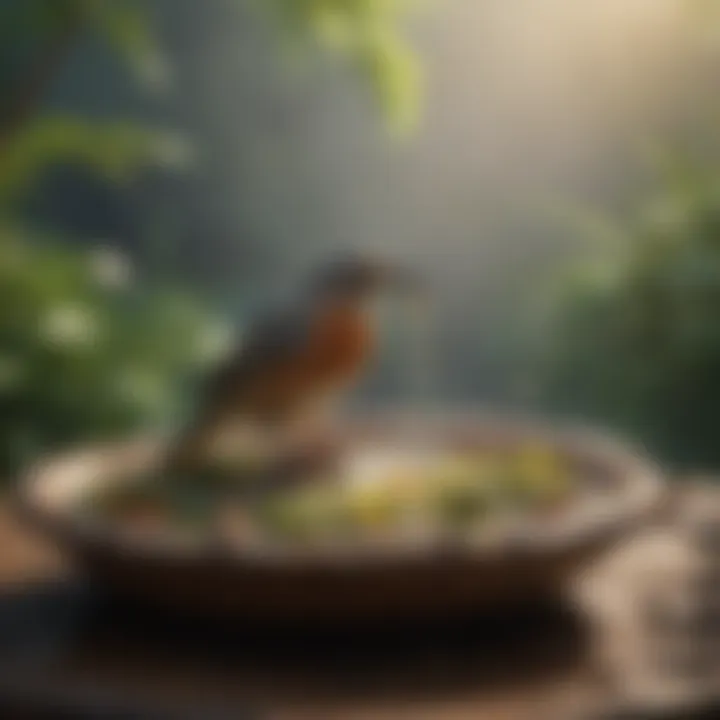
DIY Projects for Mental Stimulation
Craft enrichment implements with found/cheap items exposing resourcefulness fosters great environments. Provide tactile objects during safe play areas nearing baths.
Understanding the Importance of Bathing for Pet Birds
Proper bathing is not just a luxury for pet birds; it is a fundamental aspect of their health and well-being. Understanding the importance of bathing helps owners create a routine that promotes physical health and enhances behavioral dynamics. Different species of birds may exhibit distinct bathing preferences, but all derive essential benefits from appropriate bathing routines. Educating yourself about this topic ensures you implement effective bathing practices that can greatly contribute to their quality of life.
Physical Health Benefits
Bathing has myriad physical health benefits for pet birds. Clean feathers are crucial for insulation and waterproofing. Washing helps remove dust, dirt, and dander, preventing fungal and bacterial growth. Regular bathing also promotes healthy feather development. The action of bathing can stimulate preening, aiding in maintaining feather condition.
A well-maintained plumage allows for better temperature regulation, leading to a healthier bird overall. Additionally, spritzing or submerging during baths can aid in hydration, particularly for parrots and other tropical bird species. Increased moisture can ensure that older or molting feathers lose less structural integrity, supporting smoother growth cycles and overall fitness.
Furthermore, clean birds tend to display fewer signs of anxiety and discomfort. An essential aspect of their social behavior, clean feathers count in attracting mates amongst birds. Insufficient bathing can lead to increased irritation or stress, negatively affecting how they interact with their surroundings.
Behavioral Insights
Bathing behaviors go beyond simple grooming; they are tied to a bird's psychological state. Birds may show spontaneous enthusiasm when presented with a bath. When birds bathe regularly, it often elicits playful behaviors which fade into their overall patterns. This toughens their emotional resilience and reduces the likelihood of stress-related issues.
It is also interesting to consider behavioral observations from different species. For example, budgerigars may engage in enthusiastic splashing, while cockatiels may prefer a gentler mist. Knowing these differences equips pet owners with better insight to cater to the specific needs of their feathered companions.
Moreover, introducing a bath can serve as an engaging activity, crucial for their mental stimulation. Further adaption to new bathing methods can teach your bird, optimizing their comfort with water. Eventually, bath time can become a joyful ritual that reinforces companionship between bird and owner.
Each of these factors underscores the significance of understanding birds' bathing behaviors as a mirror into their overall contentment and health.
Types of Bird Baths Available
Understanding the different types of bird baths is crucial for pet bird owners. Each type serves distinct purposes and comes with its own unique set of benefits and installation considerations. Choosing the right bird bath can enhance your pet's bathing experience and ensure proper hygiene. In this section, we will explore various options and highlight what makes each suitable for different avian companions.
Shallow Dishes
Shallow dishes are among the simplest types of baths available. They are typically wide, flat containers that hold a small amount of water. The main advantage of shallow dishes is that they are easy to set up and maintain. Pet birds often feel secure when bathing in a dish as they have enough space to move around freely.
These dishes come in various materials such as plastic, glass, or ceramic, allowing owners to choose one that suits their aesthetic desire. However, it is important also to consider the weight. A heavier dish can stay in place better. Make sure the water is always fresh to encourage regular use. Your feathered friend needs to feel both safe and comfortable to fully engage in bathing action.
Hanging Baths
Hanging baths offer a different experience that can be magical for some bird species. Specifically designed to be suspended in the cage, they can save space and provide a sense of adventure. Many birds like hanging baths as they can mimic natural environments where they bathe in trees or off branches.
When selecting a hanging bath, consider the adjustability in height. It will help in maximizing the accessibility of the bath. Additionally, secure all parts safely to prevent any accidents. Maintenance is key; ensure regular cleaning to avoid buildup from droppings or leftover food.
Mist Sprayers
Mist sprayers are an excellent alternative for birds that may resist direct contact with water. These provide a gentle spray of water, simulating rain showers found in their natural habitats. Mist sprayers can be set to mist automatically at intervals or manually operated. To cater to birds that are anxious and reluctant to bathe, this could be the solution. The fine mist helps keep feathers clean and can also aid in hydration.
When using mist sprayers, timing is essential. Misting should be done at a comfortable hour to avoid causing stress. Finding the right sprayer with adjustable mist intensity can further comfort the birds. Keep in mind that not all birds appreciate extra moisture; so, observe the reactions and adapt accordingly.
Integrated Aviary Baths
Integrated aviary baths come designed within the bird’s living space, allowing multiple birds to bathe simultaneously. These setups usually include gradual slopes leading into the bathing area or a water feature meant to look natural, all enhancing the overall aesthetic of the aviary. This option is best for those caring for larger flocks.
An integrated bath system must be durable and capable of holding sufficient water for ample time without frequent overflow. It requires regular checks to keep the water clean. Introduce it gradually as not all birds may instantly adapt to this setup. Different kinds of bird breeds may interact differently with aviary baths, so observing their interaction becomes essential.
"Understanding each bird bath option empowers pet owners to select something that truly matches their pet's wellness needs."
Choosing the right type of bird bath is a foundational step toward ensuring your pet bird's joy and hygiene. Understanding available options can facilitate a fruitful relationship between bird and owner, showing that attentiveness to their need for cleanliness is both beneficial and fulfilling.
Selecting the Right Bath for Your Bird
Choosing the appropriate bird bath is vital for the well-being of your pet bird. Every species exhibits unique behaviors and requirements when it comes to bathing. Getting this right enhances their health, mood, and relationship with their environment.
Consideration of Bird Size and Species
Understanding the size and species of your bird is crucial when selecting a bath. Larger birds, such as macaws or cockatoos, require more space to comfortably spread their wings and immerse themselves. A shallow dish may not provide enough room, causing frustration.
Conversely, smaller species like budgerigars or finches thrive in more compact spaces. Opt for baths that mirror their natural bathing practices found in the wild.
Each species behaves differently towards water; as such, consider the individual quirks and tendencies of your bird. Larger birds might prefer deeper water, while smaller ones often enjoy a gentle sprinkle. Knowledge about your bird’s liking towards water can simplify your choice.
Environmental Factors
The environment where you place the bird bath has a significant impact on your bird's bathing experience. Factors like temperature, humidity, and airflow can enhance or detract from this experience. It is essential to select a bath that can endure changes and does not become a hazard due to external conditions.
Positioning the bath in areas that receive natural sunlight and warmth helps keep the water at a comfortable temperature. Moreover, ensure the area is clean to avoid contamination that may result from environmental factors.
Also, consider the privacy of the bathing area. Birds, especially when young or shy, might feel threatened in open spaces. Consider how they are displayed during bathtime can influence their comfort and willingness to partake.
Durable Materials
Selecting durable materials for the bird bath promotes longevity and safety. Baths made from non-toxic, high-quality materials like glass or durable plastic are favorable. These materials resist degradation from prolonged exposure to water and can withstand daily use.
Avoid any coatings that can chip off or contain toxic elements. As birds often peck or chew on nearby objects, ensuring the materials present no health risks is essential. Take notice of the thickness and sturdiness; thinner materials increase the risk of breaking or warping, creating potential hazards.
In summary, understanding bird size and species, environmental factors, and manufacturing materials guide your decision-making. Choosing the right bird bath fosters a healthy pleasure for physical and emotional stimulation for your pet.
Ensuring a bird’s bathing experience aligns with its natural instincts can contribute significantly to its total wellness.
Benefits of Regular Bathing
Bathing is not just a luxury for pet birds; it holds vital importance for their health and wellbeing. This section outlines the core benefits of regular bathing. This includes an in-depth look at feather maintenance and parasite control, essential aspects that contribute to the overall health of avian companions.
Feather Maintenance
Feathers serve several critical functions for birds, including insulation, protection, and enabling flight. Regular bathing plays a direct role in feather maintenance. It helps to keep feathers clean, removing dirt and debris buildup that may be harmful if left unattended. Additionally, bathing assists in distributing natural oils from a bird's skin, which are crucial for feather health.
When birds bathe, they immerse their feathers in water, which allows for a thorough cleansing mechanism that is uncomplicated, effective, and refreshing. Essential oils are concealed in the skin, often needing a little help to get to the feathers. Birds have a strong instinctual drive to preen, and without bath time, this can lead to subpar feather conditions and hindered grooming opportunities.
Here are some benefits of feather maintenance through baths:
- Promotes Feather Lifespan: Frequent bathing helps prolong the life of feathers by refreshing oil distribution and maintaining shaft integrity.
- Enhances Appearance: Clean, well-maintained feathers look brighter and healthier, improving the overall appearance of a pet bird.
- Stimulates Natural Behaviors: Bathing can trigger preening after bath time, contributing to healthy feather habits.
As pet owners, understanding the influence of bathing on feather condition cannot be overstated. It's essential to incorporate regular bathing into a pet bird's care routine to sustain optimum feather health.
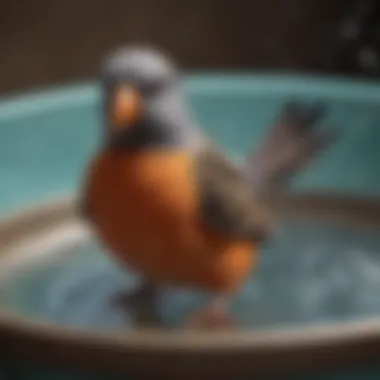
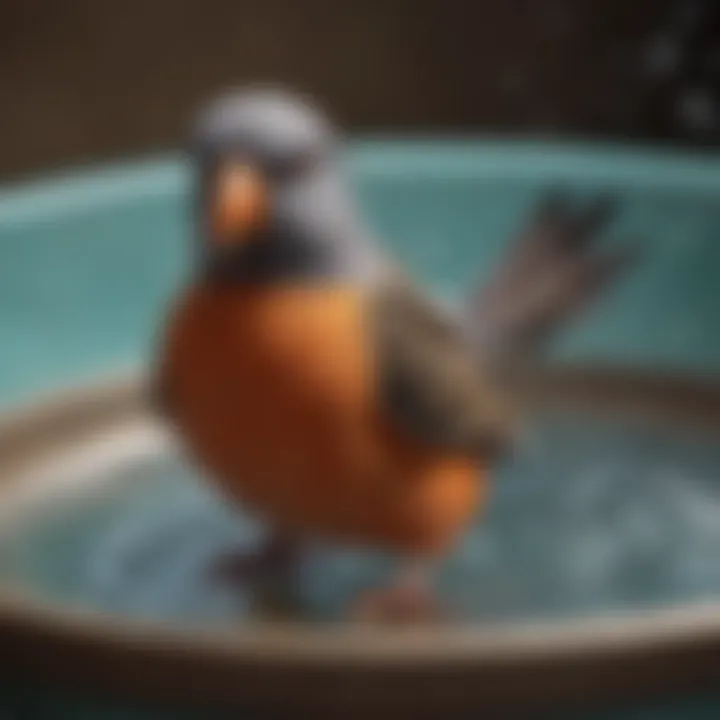
Parasite Control
Regular bathing also acts as a preventive measure against parasite infestations, common issues that can affect pet birds. Bathing helps to physically dislodge various parasites, such as mites or lice, that might find their way onto a bird’s skin or feathers.
Birds in the wild often utilize bathing as a method to protect themselves against infestations. While pet birds might not experience the same frequency of parasites as wild birds, it’s still valuable to mimic that behavior in managed care settings. Keeping the bird clean and comfortable reduces stress while decreasing the likelihood of acquiring harmful parasites.
Additional notable benefits of bathing related to parasite control include:
- Disruption of Parasite Life Cycle: Bathing interrupts the ongoing life cycle of external parasites, ensuring they do not multiply under feathers.
- Immediate Cares: Bath acts as a form of immediate reaction, promptly addressing an existing issue rather than merely relying on preventative measures.
- Lower Disease Risk: By managing parasite populations through bath frequency, the risk of diseases associated with infestations significantly reduces.
Integrating consistent bathing into a pet bird's care offers numerous benefits. It is important for not just the external feathers but also for creating a living environment that promote comfort and health. Recognizing these benefits should motivate owners to prioritize their pet's bathing routines.
Creating the Optimal Bathing Environment
Creating a suitable bathing environment is essential for the well-being of pet birds. This process involves more than just providing water for your avian friend. Key elements such as water temperature and placement of the bath significantly influence how comfortable and eager your bird will be to engage in bathing activities. Properly configured bathing conditions can enhance your bird's overall grooming behaviors and happiness.
Water Temperature Considerations
The temperature of the water is a crucial element that often gets overlooked. Birds have sensitive skin and feathers, so unsuitable water temperature can deter them from using the bath. Ideally, the water should be lukewarm, close to room temperature, allowing the bird to feel comfortable while bathing. Hot water can provoke heat stress, while cold water may be unpleasant, making birds less inclined to bathe. Incorporating a thermometer to monitor water conditions is wise. Regular checks ensure the water stays within a safe range for your bird.
Placement of the Bath
Where you place the bird bath can impact your pet’s willingness to use it. Accessibility is important; positioning the bath in a familiar and frequented area of the cage allows the bird to easily engage with it. It is also vital to consider sunlight exposure. More sunlight can warm the water, but direct intense sunlight may cause overheating. Place the bath in a shaded or partially shaded area to maintain a good balance. In addition, ensure that the bath is away from the food and sleeping areas. This helps keep the bathing process clean and enjoyable for the bird.
By skilfully managing water temperature and placement of the bath, you foster an environment that promotes instinctual cleaning behaviors among your pet birds.
Together, these considerations create a space where bathing is a natural and enjoyable routine for your feathered companions.
Bathing Frequency Guidelines
Bathing is an essential part of a bird's care routine. It promotes cleanliness and enhances overall health. The frequency of bathing can vary depending on multiple factors. Understanding these guidelines helps enlighten pet bird owners on maintaining healthy bathing habits.
Seasonal Considerations
Seasons play a crucial role in determining how frequently a bird should bathe. In warmer months, many birds naturally seek more opportunities to bath. The increased temperatures encourage feather maintenance and help in regulating body temperature. Consequently, birds may enjoy baths several times a week.
As temperatures drop during winter, the situation changes. Some birds may shy away from water due to the chill. In such cases, decreasing the bathing frequency to once a week may be prudent. However, maintaining some level of bathing during colder weather is important to avoid excess oil buildup on the feathers.
Fish or tropical birds, accustomed to high humidity, might require more frequent baths year-round. Conversely, birds that thrive in lean, dry climates may require less. Monitoring each bird’s reaction to temperature changes can guide owners in adjusting bath schedules appropriately.
Consistent bathing reflects in better feather quality and general well-being for the bird, ensuring a healthy environment for everyone involved.
Varieties of Bird Preferences
Every bird has unique preferences when it comes to bathing behavior. Regularly observing your feathered friend’s reactions can provide insight into their ideal bathing routine. Some birds relish a daily bath with enthusiasm, while others prefer selected moments of splashing. If your bird seems to ignore baths or shows reluctance, their preference must be respected, and not forced into a bathing routine.
Among parakeets, there's a noted passion for baths. Most enjoy daily sessions, expressing delight during this time. African Grey parrots, however, might show little interest. They prefer to bathe on occasion or only after noticeable accumulation of dirt.
Other birds, like canaries, tend to blend bathing urgency with their individual grooming habits. Understanding these preferences allows owners to tailor a bathing schedule that maintains cleanliness without causing stress. Noticing and adjusting to your bird's inclination can reap positive benefits in their welfare and happiness.
From lush mist applications to traditional soak-and-dry routines, identifying individual bathing joy significantly enhances pet bird care.
Adapting frequancy is key to ensuring your pet has a fulfilling bathing experience while staying clean. Following these suggestions helps form a smooth bathing routine your pet bird can enjoy.
Cleaning and Maintenance of Bird Baths
Maintaining a clean and properly functioning bird bath is crucial to the health and well-being of your pet birds. Neglecting this aspect can lead to the accumulation of harmful bacteria, algae, or parasites, which may pose health risks. A regular upkeep routine not only contributes to better feather quality and overall hygiene but aids in creating a safe and secure bathing environment.
Daily Maintenance Practices
Daily practices are essential to ensuring the water in your bird bath is inviting and clean. You should take a moment each day to check on the bird bath. Here are some practices to consider:
- Change Water Daily: Stagnant water attracts pests and encourages bacteria, so fresh water is vital.
- Remove Debris: Leaves, feathers, and discharged seeds can pollute the bathing area. Use a soft cloth or sponge to wipe away any debris.
- Monitor Water Level: Birds may splash water out of their baths making it necessary to top off the level. Keeping water at comfortable levels allows for better bathing experiences.
Knowing what to do daily ensures happy and clean feathered friends.
Deep Cleaning Recommendations
Deep cleaning is equally important and should be performed on a regular basis, such as weekly or biweekly, depending on how often the bath is used. Here's what to do:
- Use Non-Toxic Cleaners: Mix one part white vinegar with four parts water to create an effective cleaning solution. Avoid harsh soaps or chemicals harmful to birds.
- Soak and Scrub: Soak the bath in your vinegar solution and scrub it gently with a non-abrasive brush. Pay special attention to corners and crevices where dirt may lodge.
- Rinse Thoroughly: After cleaning, rinse the bath thoroughly with clean water to remove any residue. A thorough rinse is important as even traces can affect your birds' health.
- Inspect for Damage: As you clean, check for any signs of wear or damage. Cracks or rough edges may injure birds; if found, consider the need for replacement.
By practicing these deep cleaning steps, you help to prevent illness from taking hold and promote optimal health.
A clean bird bath reflects the care you provide, ensuring well-being of your feathered companions.
In summary, the perspectives on cleaning and maintenance encompass more than aesthetic considerations. Regular upkeep transforms the bathing area into more than just an appreciation of beauty; it becomes an essential ritual in safeguarding their health and enhancing their quality of life.
Safety Considerations
Understanding safety considerations is crucial when providing a bathing experience for pet birds. Birds are sensitive animals, and their well-being can be adversely affected by unsafe practices. In this section, we delve into two primary aspects: avoiding toxic cleaning products and ensuring supervision during bath time.
Avoiding Toxic Cleaning Products
The cleaning products used for maintaining bird baths must be scrutinized carefully. Many typical household cleaning agents contain chemicals that are toxic to birds. Ingredients such as alcohol, ammonia, and bleach can be deadly. When sourcing cleaning supplies, look for products that are specifically formulated for cleaning bird environments. Many birds are known to have unique respiratory systems, making them susceptible to harmful chemicals.
To maintain a safe bathing environment, consider the following options for cleaning:
- Vinegar: A natural disinfectant that kills germs without harmful fumes.
- Baking Soda: Effective for scrubbing and safe for the birds.
- Castile Soap: This is a gentle cleanser that can eliminate dirt and bacteria without harming birds.
Always rinse the bath thoroughly after applying any cleaning products to eliminate any residue that may remain. This careful selection ensures that bathing remains a pleasurable activity rather than a risk.
Supervision During Bath Time
Supervision is another vital aspect of bird bathing safety. Birds can have erratic reactions to water and bathtime can be stimulating as well as intimidating. They can slip, or even panic due to unexpected movements or other frightening elements in their environment. Therefore, being present during bathtime allows you to readily assist and monitor their emotional and physical needs.
Key pointers to remember while supervising include:
- Watch for Signs of Stress: If the bird shows signs of anxiety or distress, consider removing them from the bathing environment.
- Be Gentle: Offer encouragement and avoid sudden movements that could scare them.
- Avoid Overbathing: While bathing is essential for hygiene, too much water exposure can lead to health issues like respiratory distress.
By focusing on these safety considerations, you contribute to a healthier and happier bathing routine for your pet birds. An attentive owner can leverage both careful cleaning practices and supervision to ensure this essential activity bolsters their common well-being.
Understanding Bird Behavior During Bathing
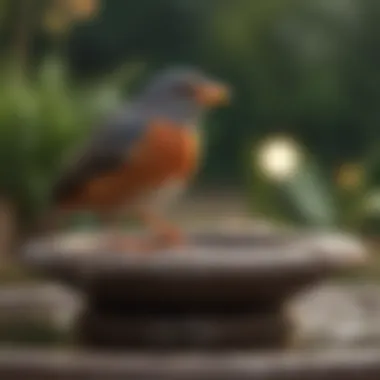
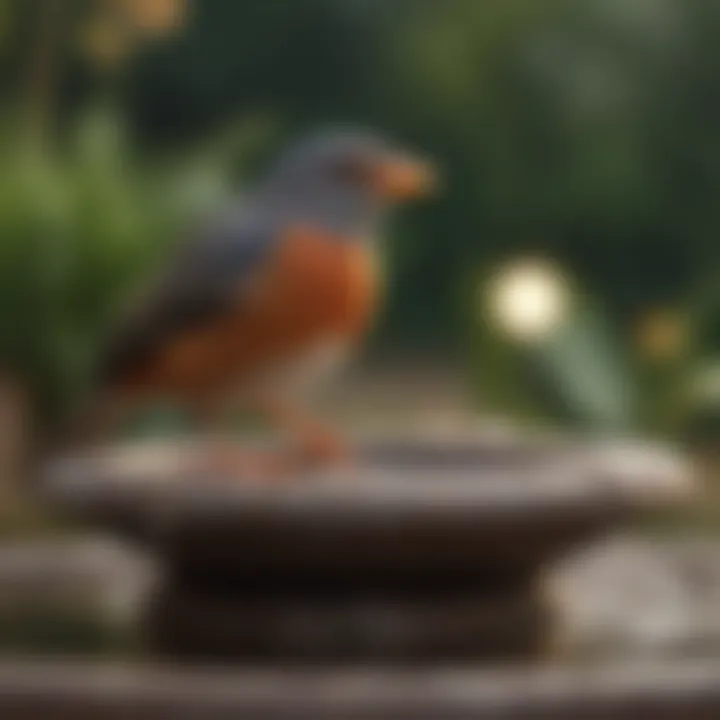
Understanding avian behavior during bathing is an essential aspect of pet bird care. Observing how birds react to water informs owners about their comfort and enjoyment level. This knowledge can enhance many factors of bird ownership, such as mental enrichment and good grooming habits.
Birds often show distinct preferences when it comes to bathing. Scrutinizing these behaviors allows owners to ensure both safety and happiness. Moreover, knowing what is typical avian behavior during bathing helps identify any potential issues or stress indicators during the process.
Regular baths not only promote physical cleanliness but also serve as a form of play and enrichment. Understanding these dimensions is key to contributing positively to a pet bird's life. Additionally, positive bathing experiences often lead to stronger owner-bird bonds.
Signs of Enjoyment
Identifying signs of pleasure while bathing can enhance the overall process for both the bird and the owner. Happy birds may exhibit behaviors such as:
- Engaging in flapping or splashing, which suggests they enjoy the water.
- Perching confidently in or around the bath, indicating comfort.
- Chirping or vocalizing, often signaling excitement.
- Preening their feathers post-bath, an indicator of contentment and cleanliness.
These actions greatly differ among species, therefore owners must learn to recognize patterns that indicate pleasure in their specific bird. For instance, parrots may exhibit more playful behavior compared to canaries, who may prefer a more gentle approach.
Addressing Reluctance to Bathe
Some birds might be hesitant or completely resistant to bathing. Understanding this reluctance is vital, as it can hint at underlying issues, whether they be fear-based or related to the bird's comfort with water. A few key considerations when addressing reluctance include:
- Gradual Introduction: Slowly introducing water using a mist or shallow dish can help a bird adjust to the concept of bathing without feeling overwhelmed.
- Positive Reinforcement: Use treats or praise to encourage the bird when they show any interest in the bath. This method connects positive experiences with bathing.
- Environmental Factors: Ensure the bathing environment is quiet and free from distractions. A serene space can greatly reduce stress for the bird.
- Temperature Checks: Ensure water is comfortably appointed; lukewarm water is often most appealing.
- Consultation: If persistent reluctance occurs, consider consulting an avian veterinarian, as it may stem from health concerns.
Addressing reluctance thoughtfully ensures that bathing becomes a welcome experience rather than a source of stress. Avian well-being thrives on happy, engaged interactions.
Innovative Bathing Solutions
Exploring innovative bathing solutions is a key aspect of understanding the dynamics around pet bird care. These advancements are useful in enhancing the bathing experience for both birds and their owners. Such innovations oftentimes reflect a deeper understanding of bird behavior and hygiene needs. By integrating modern conveniences into bird baths, pet owners can foster better health outcomes for their avian companions.
Automated Bird Baths
Automated bird baths present a significant shift in how birds can bathe smoothly and safely. These units are designed to manage water levels, temperature, and cleanliness with little to no human intervention. Many come equipped with timers or sensors that adjust water flow and monitor conditions for optimal bathing.
Benefits
- Consistent Maintenance: A self-cleaning feature ensures that the water remains fresh, which can reduce the chances of fungal or bacterial growth.
- Healthier Environment: Controlling the water temperature prevents erratic conditions that could stress birds, contributing to their overall well-being.
- Convenience: For busy bird owners, automated options offer ease of use, allowing pets to bathe without needing supervision.
Automated baths also allow owners to observe and understand their birds' bathing behaviors more effectively. This insight can help in tailoring other aspects of care.
Portable Bath Options
Portable bath solutions provide flexibility, allowing pet bird owners to move bathing areas as needed. This can be particularly advantageous during different season or for varying environments.
Considerations
- Size and Structure: Look for light-weight designs that are visibly appealing yet practical. They should fit in the home whilst catering to the dog.
- Material Durability: Ensure the materials are resistant to wear and safe to use around birds. Plastic or stainless steel options often work well.
- Refilling and Cleaning: A design that facilitates easy access for cleaning and water refills is essential. Many portability options come with easy-press release lids.
Numerous portable products in the market support the concept of bird bathing, including inflatable tubs or foldable designs for easy storage. Owners can quickly adapt bathing setups for various moods and desires of their feathered friends.
The integration of such innovative solutions not only prioritizes animal welfare but also enriches the owner-bird relationship through accessible bonding time and hassle-free interaction.
In summary, becoming familiar with automated and portable bathing options enhances the standards of care pet bird owners can provide. It fosters a hygienic, safe, and enjoyable experience that is beneficial for all involved.
Cultural and Historical Perspectives
Understanding cultural and historical perspectives on bird bathing can greatly enhance the way pet owners perceive the necessity and enjoyment of this practice. Birds bathe not just for hygiene but also as a behavior deeply rooted in their natural instincts and historical interactions with humans.
Bathing Practices in Nature
Birds in the wild display diverse bathing methods that are often influenced by their habitats. Many species utilize natural water sources like streams, lakes, or puddles to clean their feathers. This instinctual behavior serves numerous purposes. Firstly, it helps to remove dust, parasites, and other potential irritants from their plumage. Clean feathers facilitate the bird’s ability to insulate and potentially enhance flight capabilities.
In addition, while bathing, birds often engage with one another in what appears to be playful and social interactions. This communal bathing not only maintains cleanliness but fosters social bonds within their groups. Pet bird owners can replicate these natural behaviors by providing appropriately shaped and placed baths, inviting their birds to exhibit these innate tendencies in a safe environment.
Impact of Culture on Pet Bird Care
Throughout history, our relationships with captive birds have evolved significantly. Societies have shaped unique practices concerning bird care, with bathing being a gentle reminder of the nurturing behavior prominent in the wild. Cultures across the world have their own rituals involving birds. In the Orient, specific art forms depict birds in care settings, illustrating their value and cherished companionship.
In modern societies, pet bird ownership reflects similar philosophical ideas. Many owners adopt bathing regimens that align with these historical practices. This consideration directly impacts choices such as the selection of bird baths and classes of bathing frequents. Additionally, as cultures promote humane treatment and a greater awareness of animal welfare, there appears to be a growing inclination towards ensuring that pet birds simulate their natural bathing behaviors as much as possible.
Understanding rituals regarding bathing further assures pet owners of their feathered friend’s well-being, aligning in a small way with their ancestral patterns of care, whether in the wild or over messaging applications, online forums, and expert literature.
Case Studies: Bird Bath Experiences
Case studies provide vital real-world perspectives on the experiences of both pet bird owners and professionals in the field. They illustrate the importance of bird baths, shedding light on the varied motivations and methods surrounding their use. Through these testimonies, we gain valuable insights into the practical impact on birds' well-being and behavioral characteristics. Observing how different species respond to bathing rituals can inform best practices across diverse pet bird species.
Owner Experiences
Owners have unique interactions with their avian companions during bath time. Many owners share joyous tales of their birds engaging confidently with various bathing solutions. Some birds show an exuberant enthusiasm for these practices, which often leads to captivating entertainment for the owners. For instance, one owner recounts how her cockatiel, Charlie, delights in a shallow dish of warm water, frequently splashing about and singing happily.
In other cases, owners face challenges, such as birds exhibiting reluctance to bathe. An owner of a parakeet found his pet usually avoided water entirely, suggesting a previous negative experience might scar its perception. Through trials and patience, he began diming the water levels gradually and introducing mist spraying. In time, when familiarized, the parakeet warmed to the concept of bathing.
Such experiences show that understanding a bird’s individual personality can greatly influence their interaction with bathing setups. It is recommended to observe bird behavior closely to tailor the bathing experience effectively. Expressing understanding towards their preferences draws a stronger bond, enhancing as well the emotional health of the bird.
Professional Insights
Professionals such as avian veterinarians and pet behaviorists also emphasize the benefits of establishing a suitable bathing routine. They argue that bathing, when performed correctly, not only increases feather cleanliness but can also reduce stress in birds. A veterinarian specializing in avian care shared how birds displaying grooming habits were generally in more ambient conditions.
Insights from behaviorists underline the importance of presenting bathing options that align with natural behaviors of wild birds. They note how encouraging natural behaviors can aid in a variety of welfare aspects. For example, allowing a bird to partake in misty baths connection maintaains their innate need for hydration and feather maintenance.
Moreover, professionals stress the need for monitoring bath safety. Using non-toxic materials and observing bath use is just as vital as exploring diverse bathing options. Behaviorists urge owners to limit bathing disruptions to maintain a peaceful experience. Together, these perspectives help shape practices that can lead to happier, healthier birds, much like their wild counterparts.
A suitable bathing experience can greatly reduce a bird's stress, making it critical for overall bird well-being.
Ultimately, case studies provide invaluable insights from both broad trends and individualized experiences, guiding all dog owners towards best practices in bird bathing routines.
Future Trends in Bird Bathing
The realm of pet bird care is always evolving, with trends that reflect both advances in technology and changing attitudes toward avian well-being. As we consider the future trends in bird bathing, it is vital to recognize the significance these developments hold for bird owners. Staying informed about these trends can enhance the bathing experience for both birds and their caregivers, ensuring a more satisfying and accepted routine.
Emerging innovations promise better ways to address bathing habits while prioritizing the comfort and health needs of pet birds. Understanding these new options helps pet bird owners adapt to changes with relatively little effort. By keeping an eye on future trends, you can foster a healthier, more engaging environment for your feathery companions.
Technological Innovations
In recent years, technological advancements have begun to reshape bird bathing practices. Several unique innovations are becoming increasingly prominent among pet bird owners. Following are some technological innovations that deserve attention:
- Smart Bird Baths: These are baths equipped with sensors that monitor water temperature and cleanliness. Some models can even connect to mobile devices to provide alerts when clean water is necessary. This helps maintain an optimal bathing environment.
- Water Purifying Features: Several baths now come with water touch purification technology. This ensures that the water remains free from harmful bacteria, providing an enhanced level of hygiene. This is very importnat for maintaining bird health.
- Programmable Rotational Sprays: For birds who enjoy splashing or misting, some new systems incorporate programmable features. Owners can pre-set schedules for water bursts or sprays, accommodating different bathing preferences of various bird species.
- Interactive Elements: Any innovative baths that involve some play aspects have grown in popularity. Interactive opportunities can entice birds to bath, helping better integrate. Owners find that stimulating environments promote healthier habits.
Consider adopting a technologically advanced bird bath to ensure a modern approach to your pet's care.
Beyond making things easier for owners, such technologies are fundamental in aligning bird care practices with welfare needs. Investing in these bath systems leads to a more engaging experience that pleases both pet and pet owner alike, further fostering the bond they share. Additionally, owning these modern baths can set a new standard for future pet care within ecologies promoting optimal health and joy.
As you continue to navigate the changing landscape of pet songbird care, strong emphasis should be placed on selecting solutions that mesh with the personal needs of both birds and their owners. Thorough research into the evolving solutions can decidedly empower pet bird caregivers to make informed decisions for long-lasting, mutually beneficial results.















